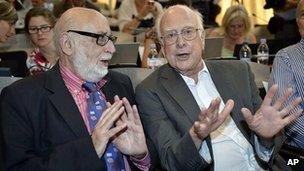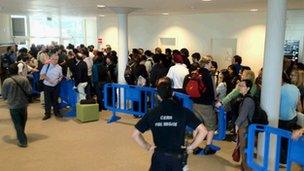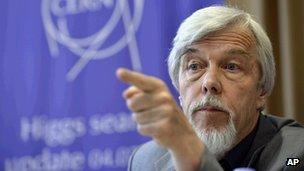LHC: Surprise and elation as signal crosses finish line
- Published

Belgium's Francois Englert (L) and the UK's Peter Higgs are now prime candidates for a Nobel
After a 45-year-long quest, the hunters have cornered their quarry.
The Large Hadron Collider (LHC), the most powerful "atom smasher" ever built, has nailed the most coveted prize in physics. Right?
Well, not quite.
Scientists at Cern (European Organization for Nuclear Research), external are confident that they have discovered a new sub-atomic particle, and a boson (those which carry forces) at that. But the question of whether it is the Higgs boson or not, never mind the simplest version vs an exotic form of the particle, remains unconfirmed.
But many think that will be more of a formality.
"We are very careful in not stating that it is the Higgs boson. It could be the Higgs boson, but I am pretty convinced it is a Higgs boson," Rolf Heuer, director-general of Cern, which operates the LHC, told BBC News.
"Our famous Standard Model contains only one Higgs. That would be the Higgs boson. But there are extensions to the Standard Model, which we need because [this theory] is not everything.
"There could be many more Higgs bosons."
Indeed, according to one idea, there could be five Higgs bosons with similar masses but different electric charges. But there are many other possible schemes to describe the "new physics" that must lie beyond the best theory of how the Universe works.
The Standard Model can only explain the 4% of the Universe that we can see, not the other 96% of the Universe that remains veiled - made up of those mysterious quantities known as dark matter and dark energy.
Particle physics is a game of statistics, relying on analysing multiple events gathered over time. Researchers work to tease out faint signals amid a sea of noise.
What might seem like a signal at first can later fade into nothingness after more numbers are gathered and crunched, so it is no surprise that physicists are usually careful to avoid the risk of jumping the gun.
But few could be in doubt about the significance of the result from the LHC.
Rolf Heuer admits to surprise about how quickly the hadron collider discovered the new Higgs-like particle, and says that the work that begins now to characterise it could make surprisingly rapid progress.
"I would not have predicted the discovery of a Higgs boson already by the middle of this year. So I think [the scientists] could work miracles," he told me here at Cern's headquarters in Geneva.
Mere weeks ago, the rumour mill suggested the certainty level for the signal had not reached the benchmark of five sigma (about a one in 3.5 million chance of a fluke) required to claim a discovery, and that the champagne would - once again - have to remain corked.
"We didn't know quite how significant this phenomenon was going to be. So it has been an extraordinarly exciting couple of weeks - very intense," says Dr Pippa Wells, from Cern, who works on the Atlas collaboration.

Physicists braved long queues to hear the results announced on Wednesday morning at Cern
But scientists continued to crunch the data up until two days before the presentations.
By Tuesday night, the excitement had reached fever pitch; many tweets about the announcement were carrying the hashtag #higgsteria - and it wasn't an exaggeration.
Cern bolted the doors to the auditorium hosting the talks from the Atlas and CMS teams, lest any sizeable group of scientists camped out overnight in the lecture theatre.
"They probably know what we're like," one particle physicist joked to me.
Indeed, physicists simply camped outside the auditorium instead. Scientists turning up at 0630 in the morning were forced to join a vast queue for seats.
But let's not forget this was a momentous day in the history of science.
The Higgs is the cornerstone of the Standard Model and, as Dr Tara Shears from the University of Liverpool says, the field of particle physics has seen nothing like this present phase of exploration "in 40 years".

Rolf Heuer says the result excludes some versions of supersymmetry theory
Compared with previous particle accelerators, Dr Shears explained, "the LHC does have that power, that [large] amount of data generated, that precision".
"Everything is coming together to achieve this moment."
Once the results were announced, showing discovery-level signals from both Atlas and CMS (the two experiments designed to search for the Higgs at the LHC) in the same part of the search region, the audience erupted with applause and cheers. Some took to their feet and pumped their fists.
There was nothing fake about this, no mutual back-slapping exercise. This was the culmination of a search that has been continuing as long as many people in the room had been physicists - a milestone some thought they might never see.
Peter Higgs, after whom the particle is named, wiped a tear from his eye, later adding: "It's really an incredible thing that it's happened in my lifetime."
It was an irritation to many journalists that he had been asked to abstain from giving his spontaneous reaction to the assembled press corps ahead of a pooled interview and a press conference at Edinburgh University on Friday.
The 83-year-old sat alongside three of the five living theorists who proposed the Higgs mechanism: François Englert, Gerald Guralnik and Carl Hagen. The other discoverers have felt overlooked by peers in the intervening years, something a Nobel Prize could go some way to redressing (depending on how it is awarded).
Some say a Nobel is far more likely to go to one or several of these theorists than the experimental team who detected the boson, as this endeavour is too much of a team effort to single out a small group of people.
For the experimental team, there will be plenty of glory to come as they get on with the task of confirming that the particle is a Higgs boson, and then determining whether it conforms to the version predicted by the Standard Model, or resembles something more exotic.
The discovery has already had an important scientific side effect. Supersymmetry is one of the proposed schemes for extending physics beyond the Standard Model and predicts that each Standard Model particle is accompanied by a heavier partner known as a "sparticle".
It has numerous variations, but some versions of the theory have tight parameters. The discovery outlined on Wednesday has dealt the final blow to some of them.
"It's exciting that the mass of this boson would exclude certain constrained models of supersymmetry, and that is a real result," said Rolf Heuer.
- Published4 July 2012
- Published4 July 2012
- Published2 July 2012